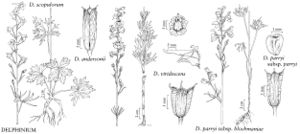Difference between revisions of "Delphinium scopulorum"
Smithsonian Contr. Knowl. 5(6): 9. 1853.
FNA>Volume Importer |
FNA>Volume Importer |
(No difference)
| |
Revision as of 22:11, 16 December 2019
Stems 50-120 cm; base often reddish, puberulent, midstems glabrous to subglabrous. Leaves mostly on proximal 1/3 of stem; basal leaves (0-)3-7 at anthesis; cauline leaves 6-15 at anthesis; petiole 0.5-15 cm. Leaf blade round to pentagonal, 1.5-10 × 2-16 cm, nearly glabrous; ultimate lobes 5-19, width 5-30 mm (basal), 1-10 mm (cauline). Inflorescences 10-30-flowered, open, cylindric; pedicel ascending to spreading, 1-3(-4.5) cm, puberulent; bracteoles 2-7 mm from flowers, green, linear, 2-4 mm, puberulent. Flowers: sepals bright dark blue, nearly glabrous, lateral sepals forward pointing, 12-15 × 4-6 mm, spurs gently decurved, slightly ascending, 15-20 mm; lower petal blades ± covering stamens, 5-8 mm, clefts 1-3 mm; hairs sparse, centered, mostly below junction of blade and claw, white. Fruits 16-20 mm, 4-4.5 times longer than wide, nearly glabrous. Seeds wing-margined; seed coat cells with margins straight, cell surfaces ± roughened. 2n = 16.
Phenology: Flowering late summer–early autumn.
Habitat: Riparian forests and open woodlands
Elevation: 1700-2600 m
Distribution

Ariz., N.Mex., Mexico (Sonora).
Discussion
Hybrids are known with Delphinium andesicola.
Selected References
None.
